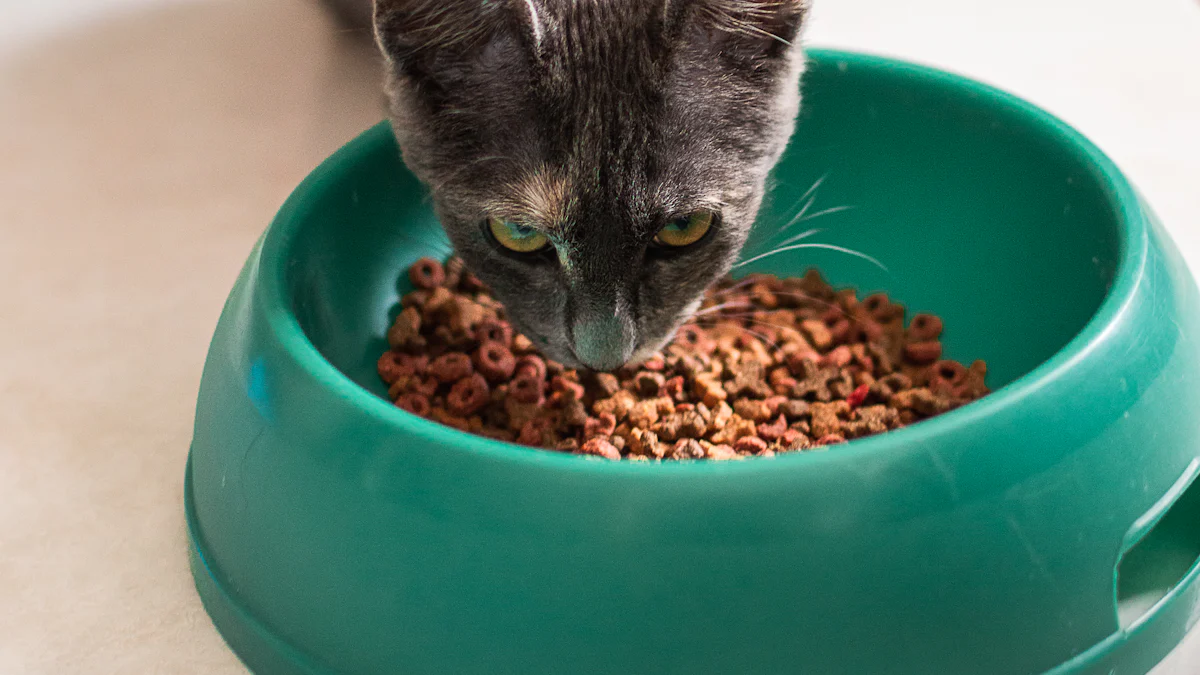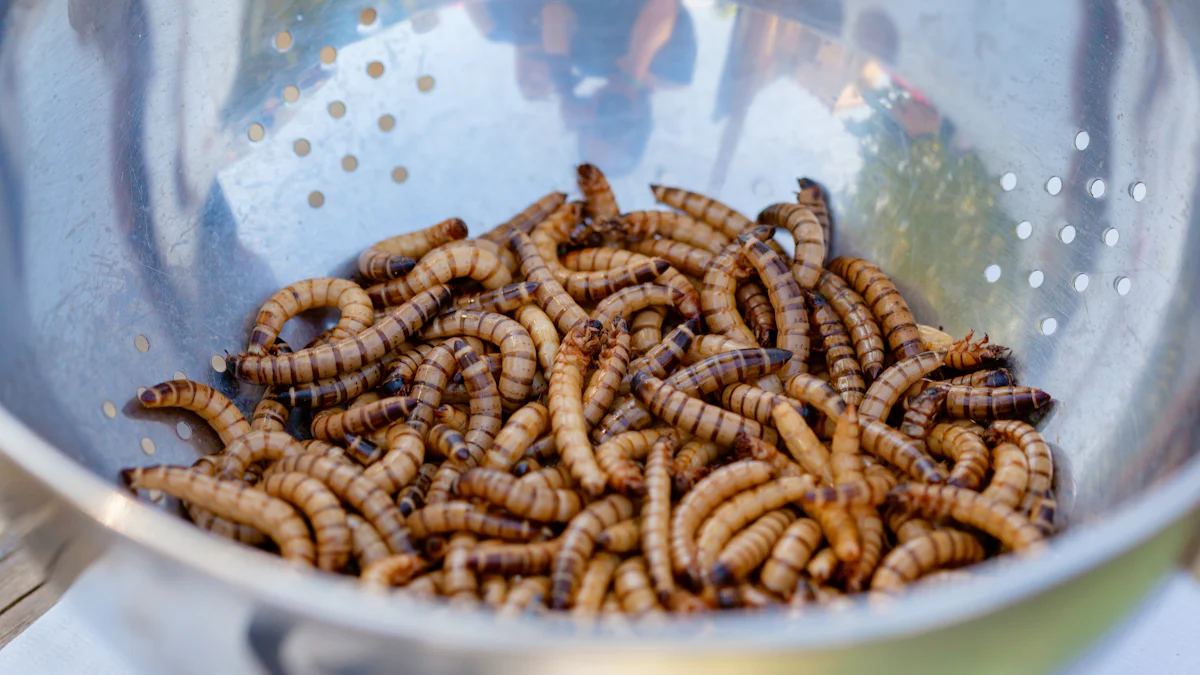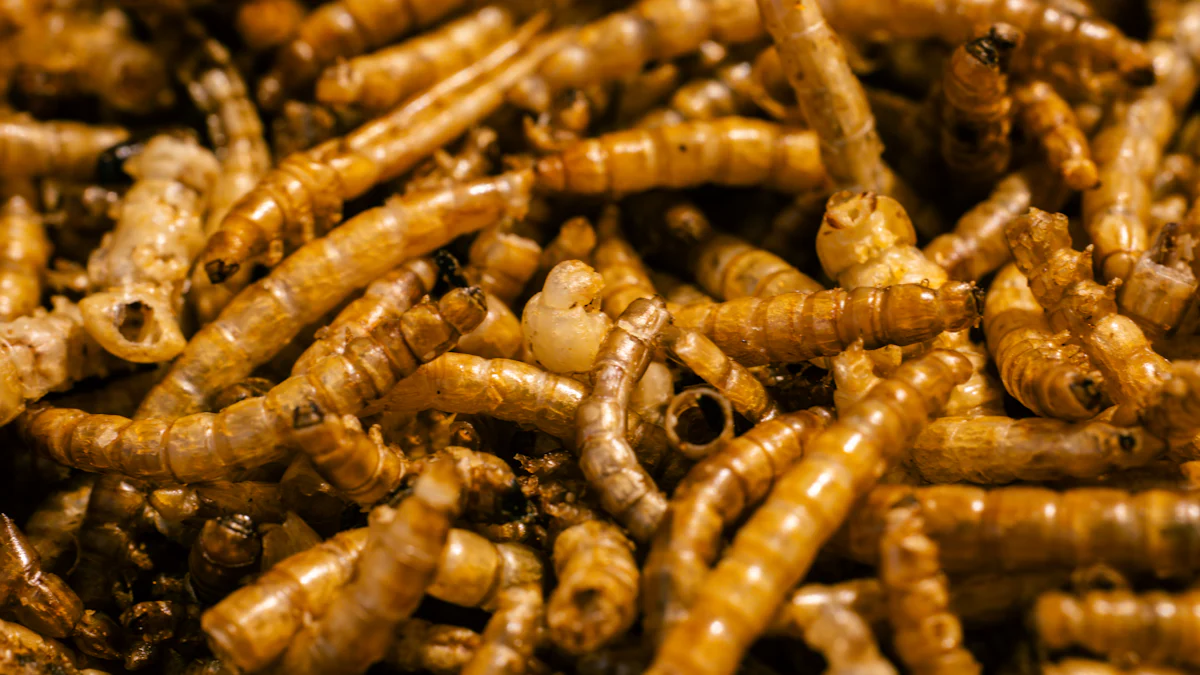
Have you ever wondered if mealworms could be a healthy snack for your furry friends? Decades ago, mealworms were staples for reptiles and birds, but they’re now gaining attention as a novel ingredient for cats and dogs. Packed with about 50 grams of protein per 100 grams, mealworms are a powerhouse of nutrients. They also provide essential fatty acids, B vitamins, and minerals like calcium and iron, which support muscle growth, energy, and overall health. Plus, their low ash content makes them a cleaner protein source compared to fish or poultry.
With the rising demand for natural and diverse pet food options, mealworms offer a sustainable and nutritious choice. Their production requires less water and land than traditional livestock, making them eco-friendly. Whether you’re curious about mealworms and cats or considering them for your dog, these tiny treats might just be the next big thing in pet nutrition.
Key Takeaways
- Mealworms are a nutrient-dense treat for pets, offering about 50-60% protein, healthy fats, and essential vitamins and minerals that support muscle growth and overall health.
- Introduce mealworms gradually into your pet’s diet to monitor for any allergies or sensitivities, and always feed them in moderation to avoid weight gain or digestive issues.
- Choose high-quality mealworms from reputable suppliers to ensure safety and nutrition, and consider them as a supplement to a balanced diet rather than a meal replacement.
Nutritional Benefits of Mealworms for Pets

Key Nutrients in Mealworms
Mealworms pack a serious nutritional punch, making them a fantastic treat for your pets. They’re loaded with protein—about 50-60% by weight—which is essential for muscle growth and repair. Alongside protein, mealworms offer healthy fats like omega-3 and omega-6 fatty acids. These fats keep your pet’s skin healthy and their coat shiny.
Mealworms also contain a variety of vitamins and minerals. B vitamins, including B12 and B2, help convert food into energy, keeping your pets active and playful. Minerals like calcium, magnesium, and zinc support strong bones and a robust immune system. Plus, the fiber in mealworms promotes good digestion and gut health.
Benefits of Mealworms for Cats and Dogs
So, why should you consider mealworms for your furry friends? For starters, they’re a natural, unprocessed source of protein. Unlike many commercial pet treats filled with fillers, mealworms provide pure nutrition. Their high protein content rivals that of beef and salmon, making them a top choice for muscle maintenance.
Mealworms also deliver energy through their fat content, which is especially beneficial for active pets. The added bonus? They’re rich in nutrients that processed pet foods often lack. Whether you’re feeding a playful puppy or a curious cat, mealworms can enhance their energy levels, digestion, and overall health.
Mealworms and Cats: A Nutritional Perspective
Cats, being obligate carnivores, thrive on protein-rich diets. Mealworms align perfectly with their dietary needs, offering a whopping 50-60% protein. This protein helps build and repair tissues while maintaining energy levels. The healthy fats in mealworms also contribute to a shiny coat, something every cat owner loves to see.
Additionally, mealworms provide essential vitamins and minerals that support your cat’s overall health. B12, for example, is crucial for nerve function and red blood cell formation. Mealworms even contain chitin, a natural prebiotic that aids digestion and promotes a healthy gut. If you’re looking for a nutritious treat for your feline friend, mealworms and cats are a match made in heaven.
Potential Risks and Precautions
Risks of Overfeeding Mealworms
Mealworms might seem like a perfect treat, but overfeeding them can cause problems for your pets. These little insects are high in fat, which can lead to weight gain or even obesity if given too often. For dogs, excessive fat intake might trigger pancreatitis, a painful condition that affects digestion. Cats can also face similar issues if their diet becomes unbalanced.
Relying too much on mealworms as a food source can create nutritional imbalances. While they’re rich in protein and healthy fats, they don’t provide all the nutrients your pet needs. This could result in deficiencies or excesses in certain vitamins and minerals. Keep an eye out for signs like lethargy, digestive upset, or changes in weight, as these might indicate overfeeding.
Allergies or Sensitivities in Pets
Just like humans, pets can have allergies or sensitivities to certain foods, including mealworms. If your cat or dog is trying mealworms for the first time, watch for symptoms of an allergic reaction. These might include itchy skin, rashes, or gastrointestinal upset like vomiting or diarrhea. In rare cases, pets might experience respiratory difficulties. If you notice any of these signs, stop feeding mealworms immediately and consult your vet.
Sourcing Safe, High-Quality Mealworms
Not all mealworms are created equal. To ensure your pet’s safety, choose mealworms from reputable suppliers. Look for farms that use sustainable and eco-friendly practices. Many suppliers now share their farming methods openly, so you can verify their quality. Buying locally can also help you get fresher products while reducing the environmental impact of transportation.
When shopping, avoid mealworms treated with chemicals or pesticides. High-quality mealworms should be free from contaminants and safe for your furry friends. Whether you’re feeding mealworms and cats or dogs, sourcing responsibly ensures your pet gets the best nutrition possible.
Feeding Mealworms to Cats and Dogs

Recommended Portion Sizes
When it comes to feeding mealworms to your pets, moderation is key. These treats are nutrient-dense, so you don’t need to offer large amounts. For dogs, a few mealworms once or twice a week can be enough, depending on their size and activity level. Cats, being smaller, should get even fewer mealworms. Think of them as a snack, not a meal replacement.
If you’re unsure about portion sizes, start small. Observe how your pet reacts and adjust accordingly. Overfeeding can lead to weight gain or upset stomachs, so it’s better to err on the side of caution. Remember, mealworms should complement a balanced diet, not replace it.
Tips for Introducing Mealworms into Their Diet
Introducing mealworms to your pet’s diet doesn’t have to be tricky. Follow these simple steps to make the process smooth:
- Start by offering mealworms in small amounts, just once or twice a week.
- If you’re using live mealworms, feed them directly. Dried mealworms might be more suitable for smaller pets.
- Combine mealworms with your pet’s regular food to maintain a balanced diet.
- Store live mealworms in a cool place and dried ones in an airtight container to keep them fresh.
- Monitor your pet’s health after introducing mealworms. Look for positive changes like increased energy or any adverse reactions.
Patience is key. Some pets might take time to accept this new treat, but with persistence, they’ll likely come around.
Raw vs. Dried Mealworms: Which Is Better?
Choosing between raw and dried mealworms depends on your pet’s needs and your convenience. Dried mealworms are a fantastic option for most pets. They’re packed with protein—up to 53% by weight—and contain essential fatty acids, vitamins, and minerals like calcium and iron. These nutrients support muscle health, energy levels, and overall well-being.
Dried mealworms are also easier to store and handle. You can keep them in a cool, dry place, and they’ll stay fresh for months. However, raw mealworms might offer slightly more hydration, which can be beneficial for pets that need extra moisture in their diet.
On the downside, both raw and dried mealworms can cause allergic reactions in some pets. Always monitor your furry friend for any signs of discomfort or sensitivity. Whichever option you choose, mealworms and cats or dogs can make a nutritious addition to their diet when fed responsibly.
Mealworms can be a fantastic treat for your pets when you feed them in moderation. They’re packed with protein, healthy fats, and essential nutrients like B vitamins and minerals. These nutrients help with muscle growth, energy, and digestion.
🐾 Tip: Always introduce mealworms gradually into your pet’s diet to avoid any sensitivities.
Here’s what to keep in mind:
- Don’t overfeed. Mealworms are nutrient-dense and high in fat.
- Watch for allergies or digestive issues.
- Choose high-quality mealworms from trusted suppliers.
With proper care, mealworms can be a safe, nutritious, and eco-friendly addition to your pet’s diet!
FAQ
Can cats and dogs eat mealworms safely?
Yes, they can! Mealworms are safe when sourced from reputable suppliers. Always introduce them gradually and monitor your pet for any adverse reactions.
How often should I feed mealworms to my pet?
Feed mealworms as an occasional treat. For dogs, offer them once or twice weekly. Cats need even smaller portions. Balance them with your pet’s regular diet.
Are mealworms better than traditional treats?
Mealworms provide high protein, healthy fats, and essential nutrients. Unlike processed treats, they’re natural and eco-friendly. They’re a great alternative for health-conscious pet owners.
🐾 Note: Always consult your vet before introducing new foods to your pet’s diet.


